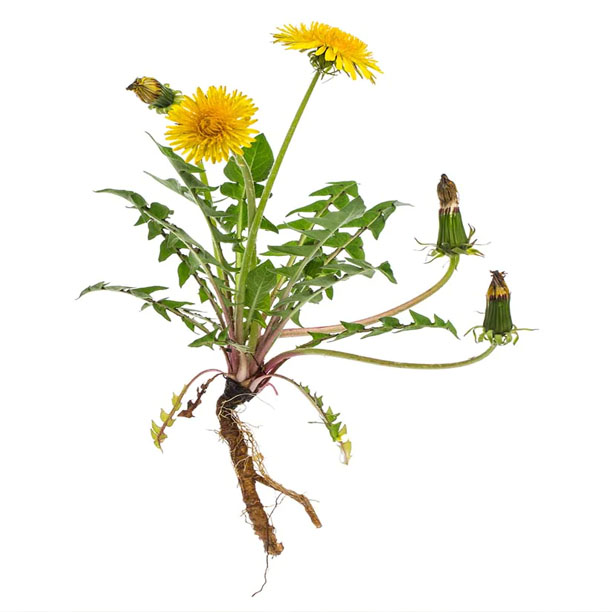Dandelion
How To Identify
Dandelions are probably the most easily identifiable herb (weed) there is. Everyone recognizes their yellow blooms and leaves and, as a bonus, the common dandelion has no poisonous lookalikes.
The hairless leaves grow in a rosette around a central taproot and can vary from lightly lobed when young, to heavily toothed when older. Dandelion flowers grow on single, unbranching, hollow stems which, like the leaves, can produce a milky sap if broken. The flowerhead has about 150 to 200 yellow ray florets that spread outward from the center. A single flower produces an average of 180 seeds which ripen 9 – 12 days after the flowers bloom. These are the very recognizable “puffballs” that get blown and spread on the wind, which is why there are so many dandelions to be found.




Benefits
Dandelions pack a whole lot of vitamins and minerals into a small plant. They’re the most nutritionally dense green you can eat, even more than kale or spinach in my opinion. Dandelion greens, in particular, are a great source of vitamins and minerals such as Vitamins A, B, C, D and K, Folate, Iron, Calcium and Potassium. An example of this is, 1 cup of dandelion greens has 535% of your daily recommended vitamin K and 112% of vitamin A. Fun fact; up until the 1800’s, people would remove their grass to plant dandelions. Quite the opposite for most lawns these days.
Lab studies have found that compounds in these plants can dial down inflammation as well as reduce blood sugar levels in people with Type 2 diabetes. The roots and leaves can naturally lower cholesterol levels and because dandelions are rich in potassium, which makes them a natural diuretic, they can be used to help control high blood pressure. The roots, leaves and flowers contain several different types of antioxidants which protect your body against free radicals which can damage your body’s cells, making you age faster.
How To Find
Dandelions are the most common broadleaf weed in most lawns. It is found in virtually every kind of habitat, from openings in deep woods to cultivated fields, from rocky hillsides to fertile gardens and lawns. Flowers are produced sporadically from early spring to late autumn.
Gathering
Gathering is pretty simple; Collect the tender, new leaves for salads or meals or any healthy-looking leaves for tinctures, salves or as a poultice. Once you have your harvest, wash them gently with water. They can be used fresh, dried or they can be blanched and frozen for later use.
The flower heads (and/or stems) can be plucked at any point but picking them at their fullest, just before they go to seed is best.
The roots can be dug up and separated from the plant also at any point but finding a plant with large, heavily toothed leaves will identify an older plant with a larger tap root. Dig about 12 inches down to loosen the soil around the root and gather as much of it as you can without breaking it. The root can be washed and used fresh, dried or they can be frozen for later use.
How To Use
There too many ways to use dandelions to list them all but some of our favorite ways are to use the leaves fresh in salads or in a sandwich as you would lettuce, cook them like spinach or dry them to use in teas.
The flower heads can be used fresh as an edible garnish for a variety of dishes, made into juice or wine, dried and added to teas or made into salves for skin irritations.
The roots can be eaten fresh but tend to be a little bitter and work best (in my opinion) roasted and ground into a delicious decaffeinated coffee.
Preservation
To preserve dandelion leaves and flower heads, place them into separate paper bags, or on a screen (window screen or similar) and allow them to dry in a dry dark place with good airflow. They can also be dehydrated using very low or no heat in a standard dehydrator or freeze dried. Oven drying isn’t recommended as the heat can damage the medicinal benefits. They can also be blanched and frozen or made into an infusion or salve for long term storage.
The roots can be dried in a similar method as the leaves and either stored as they are or roasted and ground into coffee before storing them.